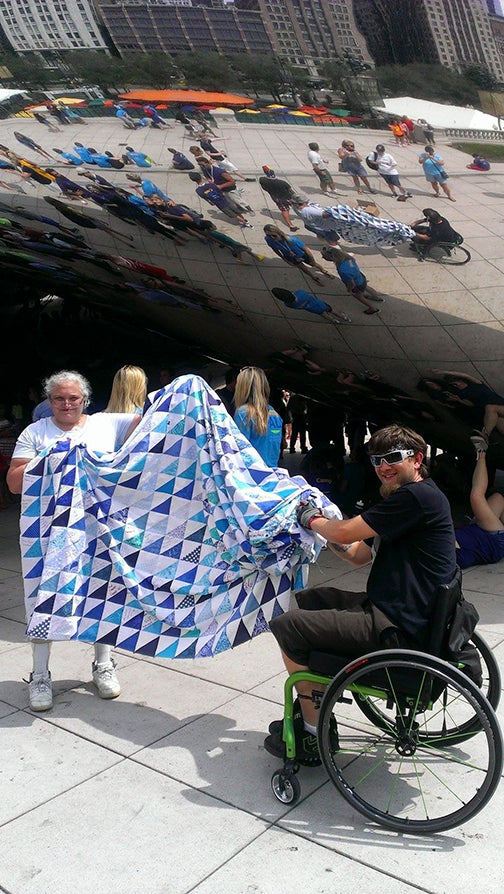Quilt travels world bringing awareness to CMT
Published 2:30 am Saturday, August 1, 2015

- Courtesy photo Sue Kanthak passes the CMT Traveling Quilt to Patrick Lorr in front of Cloud Gate, a 110-ton elliptical sculpture which reflect Chicago’s famous skyline and the clouds above at Millennium Park in Chicago, Illinois.
VIDOR — As a quilter cuts thousands of pieces of fabric to create a quilt top, the design or purpose for the quilt can change. As Angie Beaumont, of Vidor, worked on a quilt top, she realized she was creating a way to spread awareness of Charcot-Marie-Tooth Disease (CMT) and to let others across the world know they are not alone in the challenges they face.
“We have to be careful because everything can become a tripping hazard,” Beaumont said. “A small pebble, a rock, can cause us to trip.”
Beaumont was diagnosed in 1998 with CMT. Her son, 15, and daughter, 20, also have the condition.
“I was breaking my feet all the time,” Beaumont said. “I had six different breaks in my foot. They are called spontaneous stress fractures.”
Beaumont said her doctor explained it best when she said, “It is like you are a car designed to go 35 miles per hour and you are pushing it to do 50 everyday. Something is going to break.”
CMT is a group of inherited disorders that affect the peripheral nerves, which are the nerves outside the brain and spinal cord. There are more than 70 kinds of CMT. Each kind is caused by a different kind of mutation, and more causes are being discovered every year.
CMT is just one kind of neuropathy (also called peripheral neuropathy), meaning simply that the peripheral nerves are damaged. There are many other causes of neuropathy, including the most common cause—diabetes.
CMT affects about 2.8 million people worldwide, of all races and ethnic groups.
Charcot-Marie-Tooth is named after the three physicians who were the first to describe it in 1886: Jean-Martin Charcot, Pierre Marie and Howard Henry Tooth according to http://www.cmtausa.org/
Persons with CMT usually begin to experience symptoms in adolescence or early adulthood, but the onset and symptoms are quite variable even within families. The disease begins with mild indications, typically foot, ankle and hand weakness, but can progress to severe deformities, neuropathic pain, confinement to a wheelchair and the need for assisted breathing.
Some characteristics of CMT:
- High arched feet or flat feet, hammer toes, and other foot deformities
- Frequent foot and ankle sprains
- Muscle cramping
- Problems with walking, running and balance
- Hand weakness, difficulty with writing and other hand functions
- Pain in the extremities, including neuropathic pain and burning feet
At present, there are no therapies to stop or retard the disease, but there are treatment options, including physical therapy, orthotics (braces, splints and shoe inserts) and surgery. Life expectancy is usually normal, but breathing problems can exist and may be life threatening according to http://www.cmtfoundation.org/
Beaumont’s traveling quilt began visiting others across the country on September 1, 2014.
“I saw a teddy bear traveling with a journal for kids with CMT,” Beaumont said. “I thought it was a cute idea and thought of a signature quilt. The journal entries reflect that others do not feel so alone.”
The quilt is currently in Illinois and headed to Michigan next week.
“There is a mini-conference for CMT in North Carolina and they would like to display the quilt,” Beaumont said. “I hope to attend with the quilt.”
The quilt has also traveled throughout United Kingdom, Scotland and is expected to travel to Australia in the future.
A CMTA Zombie Walk 4 CMT event to raise awareness and critical funds for CMT research. This is a 5k with a 3k option. Pre-registration starts at 8 am. The Walk begins at 9 am, Saturday, September 26, 2015 at Oak Forest Elementary, 2400 Hwy. 12 in Vidor. For more information or to register http://www.firstgiving.com/CMTA/zombiewalk4cmt
For more information on CMT visit http://www.cmtausa.org/




